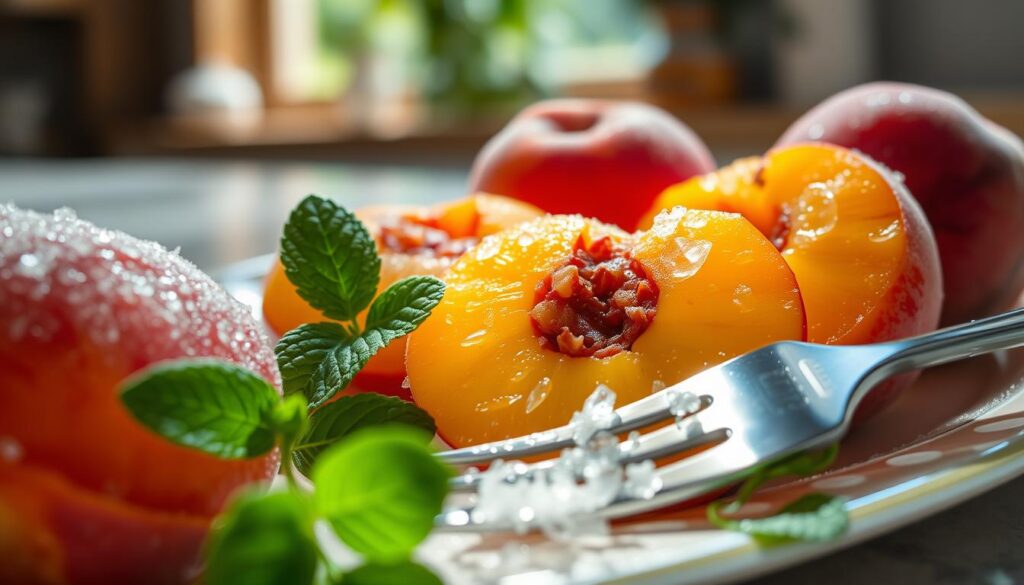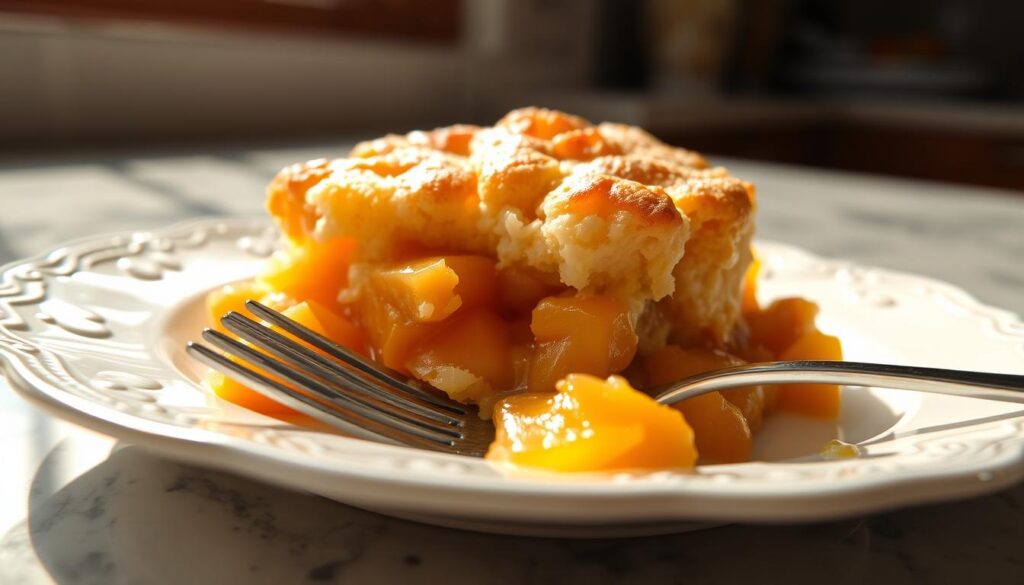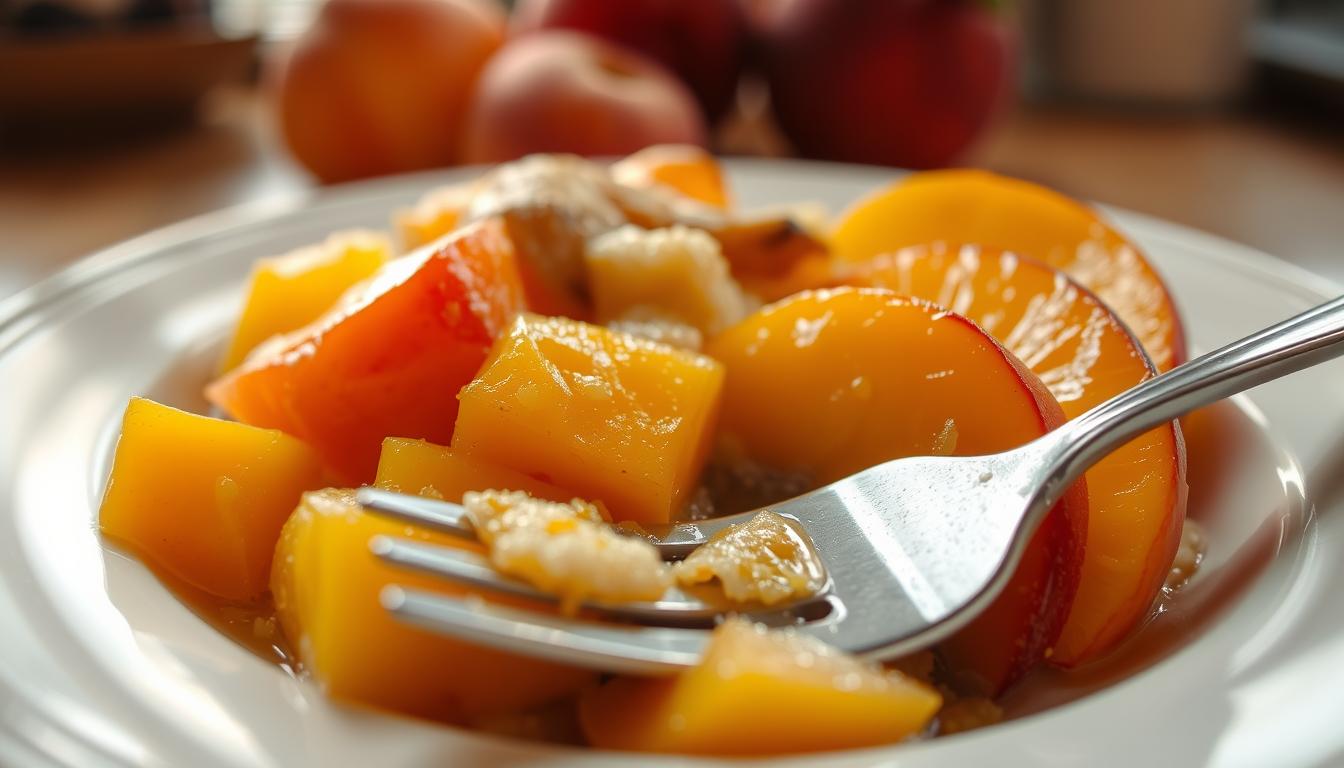The debate between using canned peaches and frozen peaches for the best peach cobbler is one that home bakers often engage in. Each option has its own benefits and drawbacks that can significantly impact the texture and flavor of your cobbler. Canned peaches offer convenience and a consistent sweetness, while frozen peaches maintain a fresher taste and may even pack more nutrients. In this section, we will delve into these two contenders, exploring their characteristics, nutritional content, and cost implications, setting the stage for a deeper understanding of baking with peaches.
Key Takeaways
- Canned peaches provide ease of use and uniform sweetness.
- Frozen peaches may offer better flavor retention and nutritional value.
- Texture and moisture levels can vary greatly between the two options.
- Cost considerations are essential when choosing the right peaches.
- Consumer preferences play a significant role in the selection for peach cobbler.
Introduction to Cobbler and Its Ingredients
Cobbler is a cherished dessert in the United States, famous for its luscious fruit fillings topped with a rich biscuit or cake-like dough. The classic choice for many cobbler recipes involves using peaches, but the dessert can include a variety of fruits. Each fruit brings its unique flavors and textures, making the selection of cobbler ingredients crucial for a delightful end result.
The basic components of a traditional cobbler include:
- Fruit (commonly peaches, but can also include berries, apples, or cherries)
- Sugar, to enhance the natural sweetness of the fruit
- Flour, which forms the base of the dough
- Butter, adding richness and flavor
Peaches hold a special place as a classic filling. Their sweetness and juicy texture provide a perfect complement to the buttery topping. Understanding the role of cobbler ingredients such as these helps bakers craft the best dessert possible.
Cobbler varieties range from traditional Southern styles to contemporary interpretations that play with flavor profiles and textures. The versatility and adaptability of this dessert highlight its enduring popularity in American kitchens.
Understanding Peaches: The Star Ingredient
Peaches stand out as a key component in peach cobbler, offering distinct flavors and textures that enhance this beloved dessert. Among the various types of peaches, two primary peach varieties emerge: freestone and clingstone. Freestone peaches, known for their easily separable pits, are often favored in desserts due to their juicy flesh and ease of preparation. Clingstone peaches, where the pit clings to the flesh, can offer a sweeter taste but require more effort to prepare.
The peak of peach season in the U.S. typically spans from late May to mid-September, providing access to fresh, ripe peaches. During this time, not only are fresh peaches plentiful, but options for canned and frozen peaches also expand in availability, allowing for year-round enjoyment. Proper sourcing of peaches during the season significantly impacts the overall flavor profile of peach cobbler. Fresh peaches, picked at their peak ripeness, offer vibrant flavors that frozen or canned versions may lack.
When baking, the texture of the peaches plays an important role in the final outcome of the dish. Selecting the right peach variety can help achieve the desired consistency. Canned peaches might be softer, while frozen peaches can retain more moisture. Ultimately, understanding these dynamics will guide bakers in choosing the best peach option for their cobbler.

Characteristics of Canned Peaches
Canned peaches are a convenient option for dessert baking, notable for their unique characteristics. Understanding their texture and flavor profile is crucial for culinary enthusiasts aiming to create the perfect cobbler. The primary differences stem from the canning process, which influences the canned peach texture and overall taste.
Texture and Flavor Profile
The texture of canned peaches is generally softer than their fresh or frozen counterparts. This makes them easier to incorporate into recipes, providing a luscious filling that blends smoothly into cobblers. The flavor of canned peaches may vary depending on the syrup used during processing. Peaches packed in syrup tend to have a sweeter taste, which can enhance the overall dessert experience, particularly in combinations with buttery crusts.
Sweetness and Syrup Considerations
When considering sweetness in canned peaches, one must note that they are often preserved in syrup or juice, which adds to their innate sweetness. This sugar content can influence the overall sweetness of the final dish. When baking with canned peaches, it’s essential to adjust other ingredients accordingly to balance flavors. Rinsing the peaches or using unsweetened varieties can help manage the syrup in canned peaches, ensuring the end result is not overly saccharine.
For more information on permissible uses and content submissions, check the terms and conditions of the Jordyn Recipes website. Understanding these characteristics will enable you to optimize your recipes and create delightful desserts that highlight the beauty of canned peaches.
Characteristics of Frozen Peaches
Frozen peaches have gained popularity due to their convenience and flavor profile. Understanding the preservation methods and the effects on texture after thawing can influence baking choices, especially when making desserts like peach cobbler.
Preservation and Storage Quality
When considering frozen peach quality, care during harvesting and freezing is essential to maintaining freshness. Peaches are typically picked at peak ripeness to ensure optimal flavor and nutritional value. Storage of frozen peaches in optimal conditions can prevent freezer burn and maintain flavor integrity. Proper packaging and temperature control during storage help preserve the delightful taste of peaches until ready for use.
Flavor and Texture After Thawing
Thawing frozen peaches requires a bit of technique to achieve the best possible outcome. The texture of thawed peaches can vary significantly depending on the thawing method. Gradual thawing in the refrigerator helps retain their cellular structure, minimizing mushiness. Many bakers find that using frozen peaches for baking leads to satisfying results, as the peaches can produce a delicious, rich flavor after freezing. Some moisture loss may occur, affecting the overall flavor after freezing, but incorporating the right amount into recipes can enhance the end product’s quality.

Incorporating frozen peaches into recipes promotes both convenience and pleasant flavors. For further insights about using peaches in desserts, this article discusses the unique aspects of frozen and canned peaches for cobbler filling here.
Comparing Nutritional Aspects
The nutritional comparison between canned and frozen peaches reveals notable differences in vitamins, minerals, calories, and overall health benefits. Many consumers wonder which option is healthier, particularly when considering how processing affects nutrients.
Vitamins and Minerals in Canned vs. Frozen
Canned peaches and frozen peaches both provide essential vitamins in peaches, yet their nutrient content can vary. Canning may lead to some loss of vitamins such as vitamin C due to heat processing. On the other hand, frozen peaches often preserve their vitamins better since they are typically flash-frozen shortly after harvest. This method helps retain their nutritional integrity, making frozen peaches a favorable choice for those seeking maximum vitamin content.
Caloric Content and Added Sugars
When evaluating calories in canned peaches, one might notice higher levels compared to calories in frozen peaches. This difference arises primarily from added sugars in canned fruit. Many canned peach varieties include syrup or sugar to enhance flavor. This addition increases calorie counts and may impact health, especially for those monitoring sugar intake. Individuals concerned about their diet should carefully read nutrition labels to make an informed choice when it comes to canned peaches vs frozen peaches.
Is it better to use canned or frozen peaches for cobbler?
Choosing between canned and frozen peaches for cobbler involves careful consideration of various factors, making the decision personal and tailored to individual preferences. Canned peaches are convenient and ready to use, often packed in syrup which can enhance the sweetness of a peach cobbler. This option suits those who prioritize ease and speed in their baking.
On the other hand, frozen peaches offer a fresh flavor profile, retaining more natural peach sweetness while avoiding added sugars found in some canned varieties. They can be a great choice for those seeking the best peaches for baking with a fresher taste. The texture after thawing may differ but can be adjusted with proper handling.
Some bakers swear by using canned peaches, finding their softness perfect for achieving that gooey, comforting feel in peach cobbler choices. Others prefer frozen peaches for their vibrant flavor, especially when properly thawed and layered. Tips from seasoned bakers often include combining both types to create a uniquely textured dessert that tantalizes the taste buds.
Taking into account personal experiences and preferences, both canned vs frozen peaches for cobbler have their merits. Whether you choose the convenience of canned or the freshness of frozen, your ultimate cobbler can be delicious with the right approach.
| Attribute | Canned Peaches | Frozen Peaches |
|---|---|---|
| Convenience | Ready-to-use, easy to find | Requires thawing but can be prepped ahead |
| Flavor | Sweet, syrupy flavor | Fresh taste, vibrant sweetness |
| Texture | Soft, often mushy | Retains more structure, needs careful thawing |
| Added Ingredients | Potential for added sugars | Typically no added sugars |
Baking with Canned Peaches
Baking with canned peaches can yield delicious results when done right. Understanding the key elements of preparing canned peaches is essential for creating a perfect canned peach cobbler. Knowing how to work with the syrup and texture of these fruits can improve your dessert’s overall flavor.
Preparation Tips for Canned Peaches
When using canned peaches, draining excess syrup is crucial. Begin by opening the can and thoroughly draining the peaches. This step prevents your cobbler from becoming overly sweet or watery. Consider the following baking tips:
- Gently pat the peaches dry with a paper towel to remove any remaining moisture.
- Adjust the sweetness of your recipe. Since canned peaches might be sweetened, taste the fruit before adding more sugar.
- Enhance flavor by mixing in a splash of lemon juice or vanilla extract, which can elevate the peach essence.
Common Mistakes to Avoid
While working with canned peaches, some baking mistakes are common. Here are essential points to keep in mind to avoid canned peach errors:
- Don’t forget to account for added moisture. Overlooking this could lead to a soggy cobbler.
- Avoid over-sweetening, which can mask the natural flavor of the peaches.
- Failing to mix ingredients adequately can result in uneven texture and flavor.
By being aware of these common baking pitfalls, you can make your canned peach cobbler a delightful treat. Follow these tips to ensure your next baking adventure is both enjoyable and successful!
Explore detailed recipes and suggestionsto make the best use of your canned peaches.
Baking with Frozen Peaches
Baking with frozen peaches can lead to a deliciously comforting cobbler when done correctly. The right preparation for baking ensures the fruit remains flavorful and maintains an appealing texture. Following a few helpful frozen peach tips can elevate your cobbler experience.
Preparation Tips for Frozen Peaches
When using frozen peaches, proper preparation is crucial. Start by thawing the fruit thoroughly. This step is essential for achieving the best results in your cobbler. Once thawed, drain any excess liquid that has formed to prevent a soggy texture in your final dish. To enhance flavor, consider tossing the peaches with a bit of sugar and lemon juice during the thawing process. These ingredients can help brighten the flavor profile of the peaches, making your frozen peach baking experience even more enjoyable.
Texture Adjustments During Baking
While baking with frozen fruit, adjustments may be necessary to account for additional moisture. Texture adjustments should be made to ensure your cobbler bakes evenly. Increase baking time by approximately 10 to 15 minutes, as the cold fruit can lower the overall temperature of the mixture. Monitoring the cobbler closely allows for optimal results. If you find the top browning too quickly, you can cover it with aluminum foil for the remaining baking time. These strategies will help achieve a delightful texture that complements the sweetness of the peaches.

Recipe Ideas for Peach Cobbler
If you’re looking to explore creative ways to enjoy peach cobbler, there’s no shortage of delicious dessert recipes that feature both canned and frozen peaches. One delightful variation is the addition of a crunchy oat topping combined with a traditional biscuit crust. For a twist on flavor, consider incorporating spices like cinnamon and nutmeg, which are perfect complements to the sweetness of peaches.
Another enticing option involves using fresh herbs such as basil or mint, adding a unique layer of flavor to your peach cobbler. You can also experiment with different forms of sugar, including brown sugar or honey, to bring out the peaches’ natural sweetness. Remember that baking with peaches means adapting to the ingredients you have on hand, whether you choose canned peaches for convenience or frozen peaches for their vibrant taste.
For those keen on healthier alternatives, explore recipes that substitute traditional crusts with gluten-free options, or even an almond flour base. Each variation will bring new dimensions to your beloved peach cobbler. Finally, for tips on ingredient accuracy, it’s always beneficial to consult reliable sources; the information shared on this site offers useful insights into recipe development. No matter your choice, these ideas will inspire countless ways to craft savory peach desserts for any occasion!

